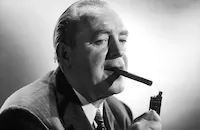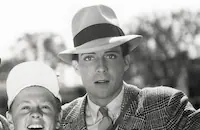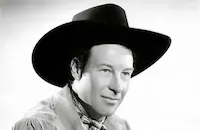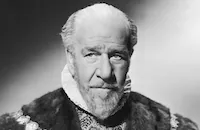China Clipper

Brief Synopsis
Cast & Crew
Ray Enright
Pat O'brien
Beverly Roberts
Ross Alexander
Humphrey Bogart
Marie Wilson
Film Details
Technical Specs

Synopsis
When importer Dave Logan's late arrival in Shanghai ruins a business deal, he realizes there is enormous potential for a commercial air service. Even though his wife, Jean, who calls herself Skippy, and his boss, Jim Horn, do their best to discourage him, he joins war buddies Dad Brunn, an airplane designer, and pilot Tom Collins, who start an air passenger line between Philadelphia and Washington, D.C. Undeterred when the airline fails, they start a second airline in Key West, Florida, to deliver mail throughout the Caribbean, and Hap Stuart, another pilot buddy, signs up. Finally, Dave's obsession with the airline drives Skippy away. Over the years, the company keeps expanding, always battling opposition from regulatory agencies and financial backers. Determined to start a trans-Pacific airline, Dave drives his men so hard that some of the pilots, including Hap, quit because of the stress. Eventually, Skippy has a change of heart and to prove it, she gets a job with Dave's company and works by his side day and night. Hap comes back too, impressed by Dave's new benefits plan for pilots. Finally everything is ready for the maiden Pacific voyage of the China Clipper. Dad sees his plane take off, but the overwork has taken its toll and he dies shortly after. Dad's death hits Dave hard. When the China Clipper hits a terrible storm off the China coast, he decides to cancel the flight, even though it means missing the deadline, but he's too late. Hap, the plane's pilot, has already taken off. Luckily, they land safely in China with five minutes to spare, and Skippy and Dave discuss a second honeymoon.

Director
Ray Enright
Cast

Pat O'brien
Beverly Roberts

Ross Alexander

Humphrey Bogart

Marie Wilson

Joseph Crehan
Joseph King

Addison Richards
Ruth Robinson

Henry B. Walthall
Carlyle Moore Jr.
Lyle Moraine

Dennis Moore

Wayne Morris
Alexander Cross

William Wright
Kenneth Harlan

Anne Nagel

Marjorie Weaver

Milburn Stone
Owen King
Hal K. Dawson
Thomas Pogue

Gordon Elliot
Jack Hatfield

Henry Stephenson
Ted Thompson
Crew
Lou Edelman
Arthur Edeson
Leo F. Forbstein
Fred Jackman
Lee Katz
Gene Lewis
Owen Marks
Orry-kelly
Max Parker
Norman Reilly Raine
William J. Van Dusen
Jack L. Warner
Frank Wead

Videos
Movie Clip



Trailer
Film Details
Technical Specs

Articles
China Clipper
Pat O'Brien stars as Dave Logan, a former World War I ace who's inspired to create a trans-Pacific airline after Charles Lindbergh crosses the Atlantic. But it takes him a while to do it. First, Dave teams up with his flying partner (Ross Alexander) and an ambitious airplane designer (Henry B. Walthall) to establish a Washington-Philadelphia line. Unfortunately, even with the help of a wealthy backer (Addison Richards), the venture goes belly-up. Undaunted, Dave recruits fellow flying ace Hap Stuart (Humphrey Bogart) to join the group in launching a Caribbean airline. When that one succeeds, he focuses on his trans-Pacific dream, which he hopes to accomplish after building a plane called The China Clipper.
Obviously, Dave is a busy guy, and it leaves little time for his loyal wife, Jean (Beverly Roberts.) Will he be able to achieve his dream while holding together his marriage? Will Jean give up and leave her brave, fly-boy husband? Frankly, it doesn't make much of a difference. Audiences were far more interested in the flying footage, which utilizes newsreel shots of real clippers as Bogart eases the plane over rough terrain and through even rougher weather. AsMonthly Film Bulletin noted at the time: "Some drama inherent in the actual achievement is lost in the manufactured drama of the fictional plot. Nevertheless, vigorous direction with considerable emphasis on close-up work smoothes over these failings and the flying in general is quite exciting. Excellent entertainment." That's all Warner Bros. was shooting for, and it turned out to be enough. One interesting bit of trivia: the screenwriter of China Clipper - Frank 'Spig' Wead - would later be the subject of a film himself, The Wings of Eagles (1957), directed by his pal, John Ford.
Producer: Samuel Bischoff, Louis F. Edelman, Hal B. Wallis, Jack L. Warner
Director: Ray Enright
Screenplay: Norman Reilly Raine, Frank Wead
Cinematography: Arthur Edeson
Film Editing: Owen Marks
Art Direction: Max Parker
Music: W. Franke Harling, Bernhard Kaun
Cast: Pat O'Brien (Dave Logan), Beverly Roberts (Jean 'Skippy' Logan), Ross Alexander (Tom Collins), Humphrey Bogart (Hap Stuart), Marie Wilson (Sunny Avery), Joseph Crehan (Jim Horn).
BW-89m.
by Paul Tatara

China Clipper
Quotes
Trivia
Henry B. Walthall collapsed on the set while filming and died shortly thereafter.
Notes
Henry B. Walthall, who plays "Dad" in the film, collapsed on the set and died shortly thereafter. The film was made with the cooperation of Pan American Airlines and is loosely based on the history of that company, which used the name "Clipper Ships" for its planes. Modern sources add the following credits: Pilot, Paul Mantz; Aerial photography, Elmer Dyer and H. F. Koenekamp.

Miscellaneous Notes
Released in United States 1936
Released in United States 1936














